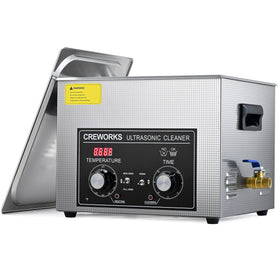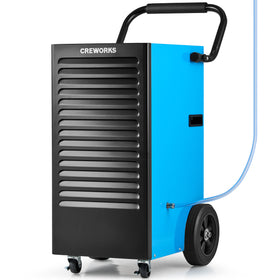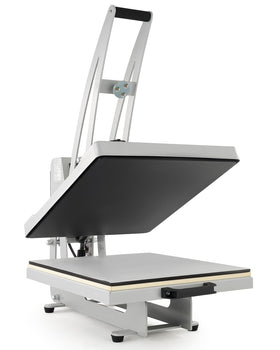With over 10000+ orders
With over 10000+ orders
Choosing the best ultrasonic cleaner size all comes down to what you are cleaning and how frequently you are going to use it. From tiny rings to larger carburetors, the tank size may be the difference between successful cleaning and failure.
Over the years, I have studied and found out that poor selection of ultrasonic machine sizes leads to wastage of time, bad outcomes, or even the spoiling of materials. Today I’ll help you select the right size of ultrasonic cleaner.

| Item Type | Recommended Ultrasonic Cleaner Size |
| Jewelry, Eyeglasses, Small Tools | 0.5–1 Liter |
| Dental/Medical Instruments, Small Engine Parts | 2–3 Liters |
| Gun Parts, Larger Metal Components | 4–6 Liters |
| Large Engine Parts, Carburetors, Lab Equipment | 10+ Liters |
With crafty items such as rings, necklaces, earrings, and even eyeglasses, you do not require a huge tank. An ultrasonic cleaner with a capacity sufficient to do the work, e.g., 0.5-1 liter of holding capacity, does not require a lot of space.
As a personal preference, I prefer smaller units to use at home since they are quite convenient to leave at home, and they warm up quickly.
Consider Crework’s 60W Knob Ultrasonic Cleaner with Digital Timer (2L) works with jewelry, glasses, and small tools. It provides a strong 60W cleaning and a 100W heater to clean fast, and it has low pressure that does not damage delicate surfaces.
It is also so quiet that you can use it without much noise in the background as you work or chill.
For cleaning dental equipment, surgical instruments, or smaller parts of your engine, a 2-3 liter ultrasonic cleaner will provide more space, without being too large.
I prefer this range due to its size, being able to fit slightly larger items, and also the cleaning cycle is not too long.
Once you become involved in the arena of gunsmithing or parts such as heavier metals, then it is going to be worth adding to the space.
A 4-6 liter ultrasonic cleaner also has the capability of fitting several parts at a time, reducing the need for multiple cleaning cycles.
It is particularly helpful when you own equipment used in a job or hobby that leaves this kind of aggravating grime. Try Creworks’s 240W Ultrasonic Cleaner with Elongated Tank (10L).
If you’re asking what size ultrasonic cleaner for carburetors or what size ultrasonic cleaner for bike parts, I’ll tell you, go big.
Large engine components, carburetors, and even lab glassware need space for proper submersion and circulation. A 10+ liter capacity ensures every surface gets hit with cavitation bubbles.
One of my favorites for these tasks is the Crework’s Upgraded 240W Ultrasonic Cleaner with Degas & Gentle Modes (10L).
Its 40kHz sound waves and 300W heater remove even the most stubborn dirt. Plus, it has degas and gentle modes, which means you can deep clean greasy carburetors one day and delicate circuit boards the next without worry.
If you work with long gun parts or narrow tools, the Creworks 240W Ultrasonic Cleaner with Elongated Tank is ideal. Its unique shape ensures every corner of your item gets cleaned, making it perfect for precision jobs.
When I’m deciding what size ultrasonic cleaner to buy, I don’t just look at the capacity in liters and call it a day. Over time, I’ve learned that size is about more than just volume; it’s about fit, function, and ultrasonic frequency. Here’s exactly how I break it down:
This is the number one mistake I see people make. A cleaner might say “10 liters,” but that measurement is for the tank, not the basket.
Since you’ll be placing your items in the basket to protect them from scratches, it’s the basket’s dimensions that determine whether your parts will actually fit.
For example, when I first tried to clean a carburetor with an ultrasonic cleaner, I assumed it would fit in my old 6L ultrasonic cleaner. Spoiler alert: it didn’t.
The basket was just a hair too small, which meant awkward positioning and less effective cleaning. Now, before I buy, I measure my largest item in length, width, and height, and compare those numbers directly to the basket size.

How often you’ll use your ultrasonic cleaner is a huge factor in picking the right size. If I’m only cleaning a ring or a pair of glasses once a month, I’m perfectly happy with a compact 2L model; it heats faster, uses less cleaning solution, and stores easily.
But if I’m deep cleaning bike parts or carburetors several times a week, I go straight for a 10L or larger. A bigger tank means I can submerge more parts at once, saving me time and reducing the wear and tear of repeated cycles.
Plus, the more often you clean, the more you’ll appreciate having room to work without cramming everything together.
This is one of the details that most people do not take into consideration, but it is significant.
When long or narrow items are the primary quantity you deal with, such as gun barrels, long wrenches, or specialized laboratory equipment, tank length is as important as volume, per se.
This is why long-tank models, such as the Creworks 240W Ultrasonic Cleaner with longer tanks, are such a great convenience. They are slim with the purpose of making those difficult pieces fit without necessarily bending them.
The main rule in selecting an ultrasonic cleaner is to know your objects, measure them, and determine how many times you will clean them. From a small 2L cleaner to a large beast of a 10L, get the right size and the cleaner will do its job better and quicker.
Not decided yet? Try Creworks 10L Ultrasonic Cleaner: it fits bike parts and carburetors, yet can be used on more delicate work since it also has a gentle mode. It is one of those gadgets that you purchase and lasts for years.
Are you ready to get the right ultrasonic cleaner? Check out our entire Crework line today and get the next level cleaning power in your home, workshop, or business.












Leave a comment